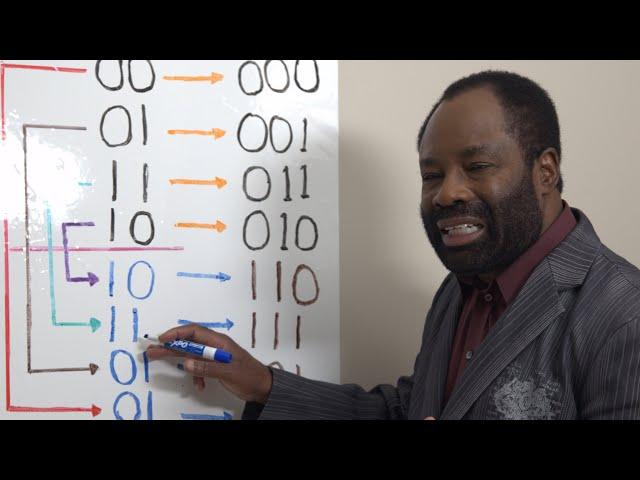
How I Invented a New Computer | Philip Emeagwali Computer | Famous Inventors and their Inventions
I’m Philip Emeagwali. At 8:15 in the morning of July 4, 1989 in Los Alamos, New Mexico, United States, practical parallel processing became my contribution to mathematical knowledge. Because that contribution is to the body of mathematical knowledge, it will remain as timeless and evergreen as Pythagoras theorem that was known to Babylonian mathematicians of 2,500 years ago. The grand challenge was not in purchasing the 65,536 processors that I harnessed. Nor was it in wiring them together. Back in the 1970s, I knew so little about parallel processing that I felt like a person
that was searching for a black goat
that was hiding
in a vast and dark universe.
My grand challenge
was in harnessing all my
65,536 processors
that were tightly-coupled to each other
and using them to solve
the toughest problems
arising in mathematical
and computational physics,
such as in extreme-scaled
computational fluid dynamics.
My grand challenge was to figure out how to divide the toughest problems
arising in extreme-scale
computational mathematics
and how to divide them into one million
(or even one billion) smaller problems
and to figure out
how to map and assign
those smaller problems
and map them
in a one-problem to one-processor
corresponded manner
that also preserved
the nearest-neighbor proximities
of my ensemble of processors.
Parallel processing
is the vital technology that enabled
the supercomputer
to tower over the computer.
The world’s fastest computer
occupies the space of a soccer field.
The world’s fastest computing
is the exclusive province
of nations
that are using the technology
to design the weapons of doom,
such as the two atomic bombs
that were dropped by the United States
upon the Japanese cities of Hiroshima
and Nagasaki
and dropped during the closing days
of the Second World War.
The world’s fastest computer
resides in the exclusive province
of the United States or China or Japan
or in a nation
that could afford the price-tag of up to
1.25 billion dollars.
My discovery of how to
parallel process across a new internet
that is a new global network of
tightly-coupled processors
that were identical to each other
and that shared nothing
between each other
was equivalent to
de facto repeatedly doubling
the word “computer”
and doing so sixteen times.
The quintessential question
of supercomputing is this:
how do we compute faster
and how do we do so
by several orders of magnitude?
What Are Supercomputers (And Physics) Used For?
The modern supercomputer
that is powered by parallel processing
is taking scientists into new territories.
Parallel processing
is the technology that enables
the supercomputer scientist
to carry out fundamental physics calculations
and to simulate details
that were previously impossible
to simulate.
Such calculations
that were beyond the previous
state-of-the-art reservoir simulations
are important for searches
for new crude oil
and natural gas deposits.
What will the field of physics be like
without the supercomputer?
In extreme-scale computational physics, the fluid flowing between
descending rocket exhaust
and the Martian atmosphere
must be parallel processed.
That computational fluid dynamical calculation
must be parallel executed across
the millions of processors
that powers the modern supercomputer.
That initial-boundary value problem
of calculus
must be discretized,
reformulated, and reduced
to an associated large-scale problem
in algebra
and be simulated a priori.
That high-resolution simulation
is a precondition
to the human exploration
of the Red Planet.
Mars is the second-smallest planet
in the Solar System.
Mars is the fourth planet from the Sun.
In extreme-scale
computational astrophysics,
the parallel processed calculation
is critical to the astrophysicist.
More Information on Philip Emeagwali:
http://emeagwali.com
https://facebook.com/emeagwali
https://twitter.com/emeagwali
https://instagram.com/philipemeagwali
https://flickr.com/philipemeagwali
https://linkedin.com/in/emeagwali
https://soundcloud.com/emeagwali
https://youtube.com/emeagwali
TAGS
Father of the Internet, supercomputer, father of the modern supercomputer, Philip Emeagwali Computer, world's fastest supercomputer, parallel processing, high performance computing, parallel computing, massively parallel supercomputers, Philip Emeagwali Supercomputer, supercomputer how to build, supercomputer of the future, philip emeagwali creates a super computer
Philip Emeagwali 191002 3 4+5+6+7 of 8
that was searching for a black goat
that was hiding
in a vast and dark universe.
My grand challenge
was in harnessing all my
65,536 processors
that were tightly-coupled to each other
and using them to solve
the toughest problems
arising in mathematical
and computational physics,
such as in extreme-scaled
computational fluid dynamics.
My grand challenge was to figure out how to divide the toughest problems
arising in extreme-scale
computational mathematics
and how to divide them into one million
(or even one billion) smaller problems
and to figure out
how to map and assign
those smaller problems
and map them
in a one-problem to one-processor
corresponded manner
that also preserved
the nearest-neighbor proximities
of my ensemble of processors.
Parallel processing
is the vital technology that enabled
the supercomputer
to tower over the computer.
The world’s fastest computer
occupies the space of a soccer field.
The world’s fastest computing
is the exclusive province
of nations
that are using the technology
to design the weapons of doom,
such as the two atomic bombs
that were dropped by the United States
upon the Japanese cities of Hiroshima
and Nagasaki
and dropped during the closing days
of the Second World War.
The world’s fastest computer
resides in the exclusive province
of the United States or China or Japan
or in a nation
that could afford the price-tag of up to
1.25 billion dollars.
My discovery of how to
parallel process across a new internet
that is a new global network of
tightly-coupled processors
that were identical to each other
and that shared nothing
between each other
was equivalent to
de facto repeatedly doubling
the word “computer”
and doing so sixteen times.
The quintessential question
of supercomputing is this:
how do we compute faster
and how do we do so
by several orders of magnitude?
What Are Supercomputers (And Physics) Used For?
The modern supercomputer
that is powered by parallel processing
is taking scientists into new territories.
Parallel processing
is the technology that enables
the supercomputer scientist
to carry out fundamental physics calculations
and to simulate details
that were previously impossible
to simulate.
Such calculations
that were beyond the previous
state-of-the-art reservoir simulations
are important for searches
for new crude oil
and natural gas deposits.
What will the field of physics be like
without the supercomputer?
In extreme-scale computational physics, the fluid flowing between
descending rocket exhaust
and the Martian atmosphere
must be parallel processed.
That computational fluid dynamical calculation
must be parallel executed across
the millions of processors
that powers the modern supercomputer.
That initial-boundary value problem
of calculus
must be discretized,
reformulated, and reduced
to an associated large-scale problem
in algebra
and be simulated a priori.
That high-resolution simulation
is a precondition
to the human exploration
of the Red Planet.
Mars is the second-smallest planet
in the Solar System.
Mars is the fourth planet from the Sun.
In extreme-scale
computational astrophysics,
the parallel processed calculation
is critical to the astrophysicist.
More Information on Philip Emeagwali:
http://emeagwali.com
https://facebook.com/emeagwali
https://twitter.com/emeagwali
https://instagram.com/philipemeagwali
https://flickr.com/philipemeagwali
https://linkedin.com/in/emeagwali
https://soundcloud.com/emeagwali
https://youtube.com/emeagwali
TAGS
Father of the Internet, supercomputer, father of the modern supercomputer, Philip Emeagwali Computer, world's fastest supercomputer, parallel processing, high performance computing, parallel computing, massively parallel supercomputers, Philip Emeagwali Supercomputer, supercomputer how to build, supercomputer of the future, philip emeagwali creates a super computer
Philip Emeagwali 191002 3 4+5+6+7 of 8
Тэги:
#Father_of_the_Internet #supercomputer #father_of_the_modern_supercomputer #Philip_Emeagwali_Computer #world's_fastest_supercomputer #parallel_processing #high_performance_computing #parallel_computing #massively_parallel_supercomputers #Philip_Emeagwali_Supercomputer #supercomputer_how_to_build #supercomputer_of_the_future #philip_emeagwali_creates_a_super_computerКомментарии:
Қуырылған картоп. Жаренная картошка
Gulziya_Yessetova
Cinematic drone shots Catamarca, Argentina | DJI Mini 2
BlackforestDrones
Стрелок 3 Драка на стоянке
Vovankinoman
Brostik - Paka Poka (Slowed)
Alex's List
Рик и Морти 1 сезон 1 серия (1-й эпизод)
Алексей Санчез
10 Jamie Oliver Recipes To Try At Home This Weekend
Jamie Oliver TV
UCSB Panhellenic: Alpha Chi Omega House Tour
UCSB Panhellenic





![Adobe Spark Post - Full Walk Through Tutorial [2021] Adobe Spark Post - Full Walk Through Tutorial [2021]](https://invideo.cc/img/upload/SXVkZUJtbHRZQkc.jpg)




















